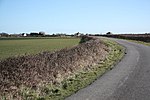Claythorpe

Claythorpe is a hamlet about 5 miles (8 km) north-west from the town of Alford, Lincolnshire, England, most notable for its water mill. The population is now included in the civil parish of Authorpe. Claythorpe Mill was for a time a restaurant but is now a visitor attraction with wildfowl gardens, animals and a cafe. It was known previously as Empire Mills when it was built as a corn mill in the 18th century. It was largely rebuilt in the 19th century, and the top floor was destroyed by fire and rebuilt again in 1890. Originally powered by a water wheel it has worked using a turbine since 1890, which is housed at the rear of the building. The steel wheel and gearing are still there, and it is a Grade II listed building. It was the last regularly working water mill in Lincolnshire, although it has not been in use since 1977.Claythorpe Manor (formerly Claythorpe Hall) is a Grade II listed red brick farmhouse dating from the 18th century.
Excerpt from the Wikipedia article Claythorpe (License: CC BY-SA 3.0, Authors, Images).Claythorpe
East Lindsey
Geographical coordinates (GPS) Address Nearby Places Show on map
Geographical coordinates (GPS)
| Latitude | Longitude |
|---|---|
| N 53.290807 ° | E 0.119136 ° |
Address
LN13 0DU East Lindsey
England, United Kingdom
Open on Google Maps







